CALB Immobilized onto Magnetic Nanoparticles for Efficient Kinetic Resolution of Racemic Secondary Alcohols: Long-Term Stability and Reusability
Abstract
1. Introduction
2. Results and Discussion
2.1. Chemical Characterization and Analysis
2.2. Optimal Conditions for the Preparation of Immobilized CALB
2.3. Optimal Conditions for the Resolution of 1-Phenylethanol
2.4. Reusability of Magnetic CALB CLEAs
2.5. Storage Stability of Magnetic CALB CLEAs
2.6. Kinetic Resolution of Different Secondary Alcohols
3. Materials and Methods
3.1. Materials
3.2. Expression of CALB
3.3. Preparation of Modified Magnetic Fe3O4 Nanoparticles
3.4. Preparation of CALB CLEAs and Magnetic CLEAs of CALB
3.5. Activity Assay
3.6. Calculation
3.7. Characterization
3.7.1. FTIR
3.7.2. SEM
3.7.3. HPLC
3.7.4. 1H-NMR
3.8. Optimization for Magnetic CALB CLEAs Preparation
3.9. 1-Phenylethanol Resolution Reusability
4. Conclusions
Supplementary Materials
Author Contributions
Funding
Acknowledgments
Conflicts of Interest
References
- Sheldon, R.A.; van Pelt, S. Enzyme immobilisation in biocatalysis: Why, what and how. Chem. Soc. Rev. 2013, 42, 6223–6225. [Google Scholar] [CrossRef] [PubMed]
- Zheng, M.M.; Xiang, X.; Wang, S.; Shi, J.; Deng, Q.C.; Huang, F.H.; Cong, R.H. Lipase immobilized in ordered mesoporous silica: A powerful biocatalyst for ultrafast kinetic resolution of racemic secondary alcohols. Process Biochem. 2017, 53, 102–108. [Google Scholar] [CrossRef]
- Todea, A.; Borza, P.; Cimporescu, A.; Paul, C.; Peter, F. Continuous kinetic resolution of aliphatic and aromatic secondary alcohols by sol-gel entrapped lipases in packed bed bioreactors. Catal. Today 2018, 306, 223–232. [Google Scholar] [CrossRef]
- Belafriekh, A.; Secundo, F.; Serra, S.; Djeghaba, Z. Enantioselective enzymatic resolution of racemic alcohols by lipases in green organic solvents. Tetrahedron Asymmetry 2017, 28, 473–478. [Google Scholar] [CrossRef]
- Rivera-Ramirez, J.D.; Escalante, J.; Lopez-Munguia, A.; Marty, A.; Castillo, E. Thermodynamically controlled chemoselectivity in lipase-catalyzed aza-Michael additions. J. Mol. Catal. B Enzym. 2015, 112, 176–182. [Google Scholar] [CrossRef]
- Jung, S.; Kim, J.; Park, S. Rational design for enhancing promiscuous activity of Candida antarctica lipase B: A clue for the molecular basis of dissimilar activities between lipase and serine-protease. RSC Adv. 2013, 3, 2590–2594. [Google Scholar] [CrossRef]
- Xu, F.; Xu, J.; Hu, Y.J.; Lin, X.F.; Wu, Q. One-pot bienzymatic cascade combining decarboxylative aldol reaction and kinetic resolution to synthesize chiral b-hydroxy ketone derivatives. RSC Adv. 2016, 6, 76829–76837. [Google Scholar] [CrossRef]
- Ursoiu, A.; Paul, C.; Kurtan, T.; Peter, F. Sol-gel Entrapped Candida antarctica lipase B-A Biocatalyst with Excellent Stability for Kinetic Resolution of Secondary Alcohols. Molecules 2012, 17, 13045–13061. [Google Scholar] [CrossRef]
- Zhang, X.M.; Jing, L.Y.; Chang, F.F.; Chen, S.; Yang, H.Q.; Yang, Q.H. Positional immobilization of Pd nanoparticles and enzymes in hierarchical yolk–shell@shell nanoreactors for tandem catalysis. Chem. Commun. 2017, 53, 7780–7783. [Google Scholar] [CrossRef]
- Cipolatti, E.P.; Valerio, A.; Henriques, R.O.; Moritz, D.E.; Ninow, J.L.; Freire, D.M.J.; Manoel, E.A.; Fernandez-Lafuente, R.; de Oliveiraet, D. Nanomaterials for biocatalyst immobilization –state of the art and future trends. RSC Adv. 2016, 6, 104675–104692. [Google Scholar] [CrossRef]
- Jose, C.; Toledo, M.V.; Nicolás, P.; Lasalle, V.; Ferreira, M.L.; Briand, L.E. Influence of the nature of the support on the catalytic performance of CALB: Experimental and theoretical evidence. Catal. Sci. Technol. 2018, 8, 3513–3526. [Google Scholar] [CrossRef]
- Hartmann, M.; Kostrov, X. Immobilization of enzymes on porous silicas-benefits and challenges. Chem. Soc. Rev. 2013, 42, 6277–6289. [Google Scholar] [CrossRef]
- Rodrigues, R.C.; Ortiz, C.; Berenguer-Murcia, A.; Torres, R.; Fernandez-Lafuente, R. Modifying enzyme activity and selectivity by immobilization. Chem. Soc. Rev. 2013, 42, 6290–6307. [Google Scholar] [CrossRef]
- Hwang, E.T.; Gu, M.B. Enzyme stabilization by nano/microsized hybrid materials. Eng. Life Sci. 2013, 13, 49–61. [Google Scholar] [CrossRef]
- Lian, X.Z.; Fang, Y.; Joseph, E.; Wang, Q.; Li, J.L.; Banerjee, S.Y.; Lollar, C.; Wang, X.; Zhou, H.C. Enzyme–MOF (metal–organic framework) composites. Chem. Soc. Rev. 2017, 46, 3386–3401. [Google Scholar] [CrossRef] [PubMed]
- Zhou, Z.; Hartmann, M. Progress in enzyme immobilization in ordered mesoporous materials and related applications. Chem. Soc. Rev. 2013, 42, 3894–3912. [Google Scholar] [CrossRef]
- Zhang, W.W.; Wang, N.; Zhang, L.; Wu, W.X.; Hu, C.L.; Yu, X.Q. Effects of Additives on Lipase Immobilization in Microemulsion-Based Organogels. Appl. Biochem. Biotechnol. 2014, 172, 3128–3140. [Google Scholar] [CrossRef] [PubMed]
- Zhang, W.W.; Wang, N.; Feng, X.W.; Zhang, Y.; Yu, X.Q. Biocatalytic Synthesis of Optically Active Hydroxyesters via Lipase-Catalyzed Decarboxylative Aldol Reaction and Kinetic Resolution. Appl. Biochem. Biotechnol. 2014, 173, 535–543. [Google Scholar] [CrossRef] [PubMed]
- Mehrasbi, M.R.; Mohammadi, J.; Peyda, M.; Mohammadi, M. Covalent immobilization of Candida antarctica lipase on core-shell magnetic nanoparticles for production of biodiesel from waste cooking oil. Renew. Energy 2017, 101, 593–602. [Google Scholar] [CrossRef]
- Nicolas, P.; Lassalle, V.; Ferreira, M.L. Immobilization of CALB on lysine-modified magnetic nanoparticles: Influence of the immobilization protocol. Bioprocess Biosyst Eng. 2018, 41, 171–184. [Google Scholar] [CrossRef] [PubMed]
- Garcia-Galan, C.; Berenguer-Murcia, A.; Fernandez-Lafuente, R.; Rodrigues, R.C. Potential of Different Enzyme Immobilization Strategies to Improve Enzyme Performance. Adv. Synth. Catal. 2011, 353, 2885–2904. [Google Scholar] [CrossRef]
- Sheldon, R.A. Characteristic features and biotechnological applications of cross-linked enzyme aggregates (CLEAs). Appl. Microbiol. Biotechnol. 2011, 92, 467–477. [Google Scholar] [CrossRef] [PubMed]
- Kartal, F.; Janssen, M.H.A.; Hollmann, F.; Sheldon, R.A.; Kilinc, A. Improved esterification activity of Candida rugosa lipase in organic solvent by immobilization as Cross-linked enzyme aggregates (CLEAs). J. Mol. Catal. B Enzym. 2011, 71, 85–89. [Google Scholar] [CrossRef]
- Sheldon, R.A. Cross-linked enzyme aggregates (CLEA®s): Stable and recyclable biocatalysts. Biochem. Soc. Trans. 2007, 35, 1583–1587. [Google Scholar] [CrossRef] [PubMed]
- Sheldon, R.A. Cross-Linked Enzyme Aggregates as Industrial Biocatalysts. Process Res. Dev. 2011, 15, 213–223. [Google Scholar] [CrossRef]
- Nadar, S.S.; Rathod, V.K. Magnetic macromolecular cross linked enzyme aggregates (CLEAs) of glucoamylase. Enzym. Microb. Technol. 2016, 83, 78–87. [Google Scholar] [CrossRef] [PubMed]
- Mehde, A.A.; Mehdi, W.A.; Ozacar, M.; Ozacar, Z.Z. Evaluation of different saccharides and chitin as eco-friendly additive to improve the magnetic cross-linked enzyme aggregates (CLEAs) activities. Int. J. Biol. Macromol. 2018, 118, 2040–2050. [Google Scholar] [CrossRef]
- Pashangeh, K.; Akhond, M.; Karbalaei-Heidari, H.R.; Absalan, G. Biochemical characterization and stability assessment of Rhizopus oryzae lipase covalently immobilized on amino-functionalized magnetic nanoparticles. Int. J. Biol. Macromol. 2017, 105, 300–307. [Google Scholar] [CrossRef]
- Raita, M.; Arnthong, J.; Champreda, V.; Laosiripojana, N. Modification of magnetic nanoparticle lipase designs for biodiesel production from palm oil. Fuel Process. Technol. 2015, 134, 189–197. [Google Scholar] [CrossRef]
- Bandikari, R.; Qian, J.X.; Baskaran, R.; Liu, Z.D.; Wu, G.B. Bio-affinity mediated immobilization of lipase onto magnetic cellulose nanospheres for high yield biodiesel in one time addition of methanol. Bioresour Technol. 2017, 249, 354–360. [Google Scholar] [CrossRef]
- Zhang, W.W.; Yang, H.X.; Liu, W.Y.; Wang, N.; Yu, X.Q. Improved Performance of Magnetic Cross-Linked Lipase Aggregates by Interfacial Activation: A Robust and Magnetically Recyclable Biocatalyst for Transesterification of Jatropha Oil. Molecules 2017, 22, 2157. [Google Scholar] [CrossRef]
- Kasche, V. Mechanism and yields in enzyme catalysed equilibrium and kinetically controlled synthesis of β-lactam antibiotics, peptides and other condensation products. Enzym. Microb. Technol. 1986, 8, 4–16. [Google Scholar] [CrossRef]
- Xie, W.L.; Ma, N. Immobilized Lipase on Fe3O4 Nanoparticles as Biocatalyst for Biodiesel Production. Energy Fuels 2009, 23, 1347–1353. [Google Scholar] [CrossRef]
- Devi, B.L.A.P.; Guo, Z.; Xu, X. Characterization of cross-linked lipase aggregates. J. Am. Oil Chem. Soc. 2009, 86, 637–642. [Google Scholar] [CrossRef]
- Zhang, W.W.; Yang, X.L.; Jia, J.Q.; Wang, N.; Hu, C.L.; Yu, X.Q. Surfactant-activated magnetic cross-linked enzyme aggregates (magnetic CLEAs) of Thermomyces lanuginosus lipase for biodiesel production. J. Mol. Catal. B Enzym. 2015, 115, 83–89. [Google Scholar] [CrossRef]
- Jia, J.Q.; Zhang, W.W.; Yang, Z.J.; Yang, X.L.; Wang, N.; Yu, X.Q. Novel Magnetic Cross-Linked Cellulase Aggregates with a Potential Application in Lignocellulosic Biomass Bioconversion. Molecules 2017, 22, 269. [Google Scholar] [CrossRef]
- Barbosa, O.; Ortiz, C.; Berenguer-Murcia, A.; Torres, R.; Rodrigues, R.C.; Fernandez-Lafuente, R. Glutaraldehyde in bio-catalysts design: A useful crosslinker and a versatile tool in enzyme immobilization. RSC Adv. 2013, 4, 1583–1600. [Google Scholar] [CrossRef]
- Barbosa, O.; Torres, R.; Ortiz, C.; Fernandez-Lafuente, R. Versatility of glutaraldehyde to immobilize lipases: Effect of the immobilization protocol on the properties of lipase B from Candida antarctica. Process Biochem. 2012, 47, 1220–1227. [Google Scholar] [CrossRef]
- Monsan, P. Optimization of glutaraldehyde activation of a support for enzyme immobilization. J. Mol. Catal. 1978, 3, 371–384. [Google Scholar] [CrossRef]
- Patel, V.; Nambiar, S.; Madamwar, D. An extracellular solvent stable alkaline lipase from Pseudomonas sp. DMVR46: Partial purification, characterization and application in non-aqueous environment. Process Biochem. 2014, 49, 1673–1681. [Google Scholar] [CrossRef]
- Laane, C.; Boeren, S.; Vos, K.; Veeger, C. Rules for optimization of biocatalysis in organic solvents. Biotechnol. Bioeng. 1987, 30, 81–87. [Google Scholar] [CrossRef] [PubMed]
- Kasche, V.; Haufler, U.; Riechmann, L. Equilibrium and kinetically controlled synthesis with enzymes: Semisynthesis of penicillins and peptides. Methods Enzymol. 1987, 136, 280–292. [Google Scholar] [PubMed]
- Mateo, C.; Palomo, J.M.; Fernandez-Lorente, G.; Guisan, J.M.; Fernandez-Lafuente, R. Improvement of enzyme activity, stability and selectivity via immobilization techniques. Enzym. Microb. Technol. 2007, 40, 1451–1463. [Google Scholar] [CrossRef]
- Syren, P.O.; Hendil-Forssell, P.; Aumailley, L.; Besenmatter, W.; Gounine, F.; Svendsen, A.; Martinelle, M.; Hult, K. Esterases with an Introduced Amidase-Like Hydrogen Bond in the Transition State Have Increased Amidase Specificity. ChemBioChem 2012, 13, 645–648. [Google Scholar] [CrossRef] [PubMed]
- Li, X.; Wei, J.P.; Scott, E.R.; Liu, J.W.; Guo, S.; Li, Y.; Zhang, L.; Han, W.Y. Exogenous Melatonin Alleviates Cold Stress by Promoting Antioxidant Defense and Redox Homeostasis in Camellia sinensis L. Molecules 2018, 23, 165. [Google Scholar] [CrossRef] [PubMed]
Sample Availability: Samples of the compounds are not available from the authors. |
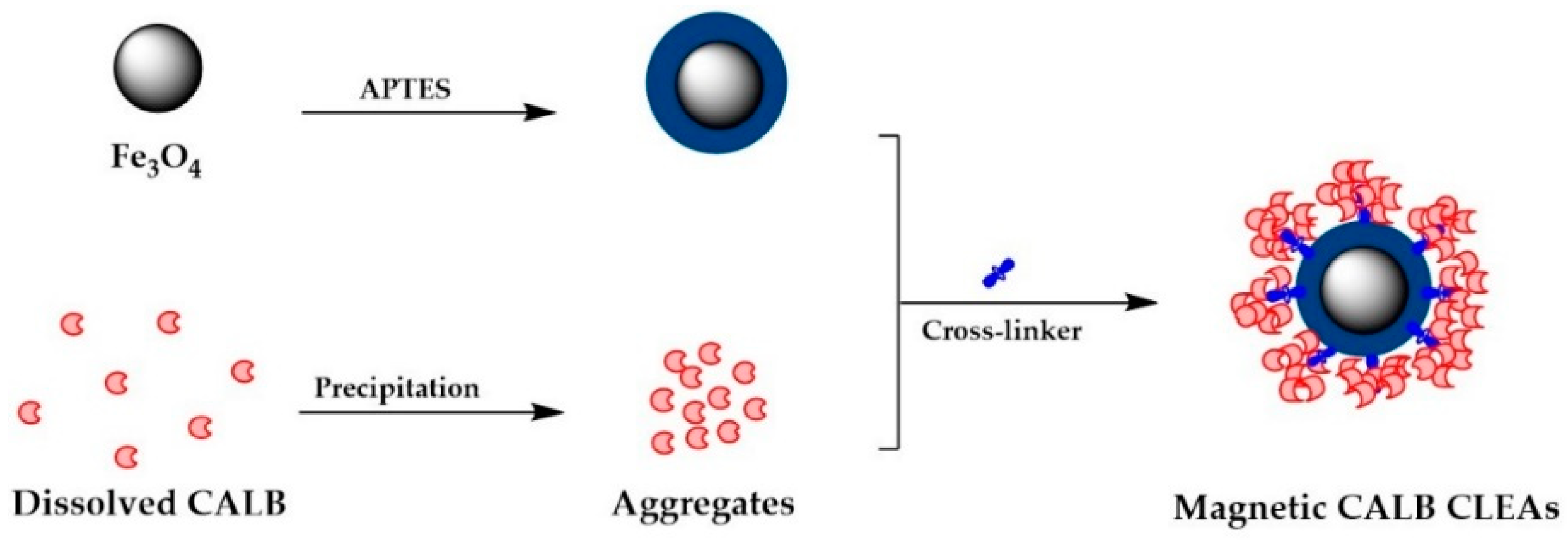
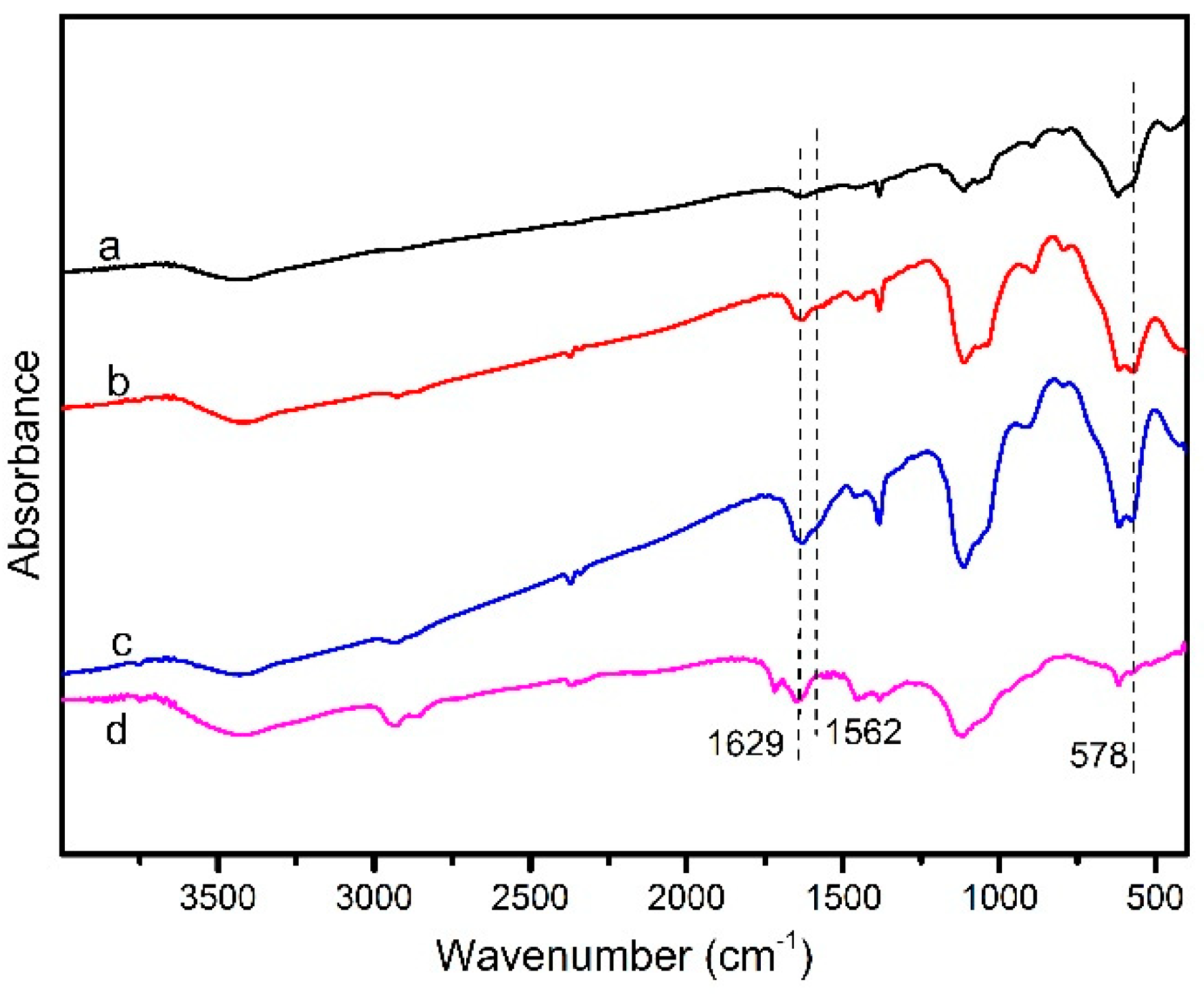

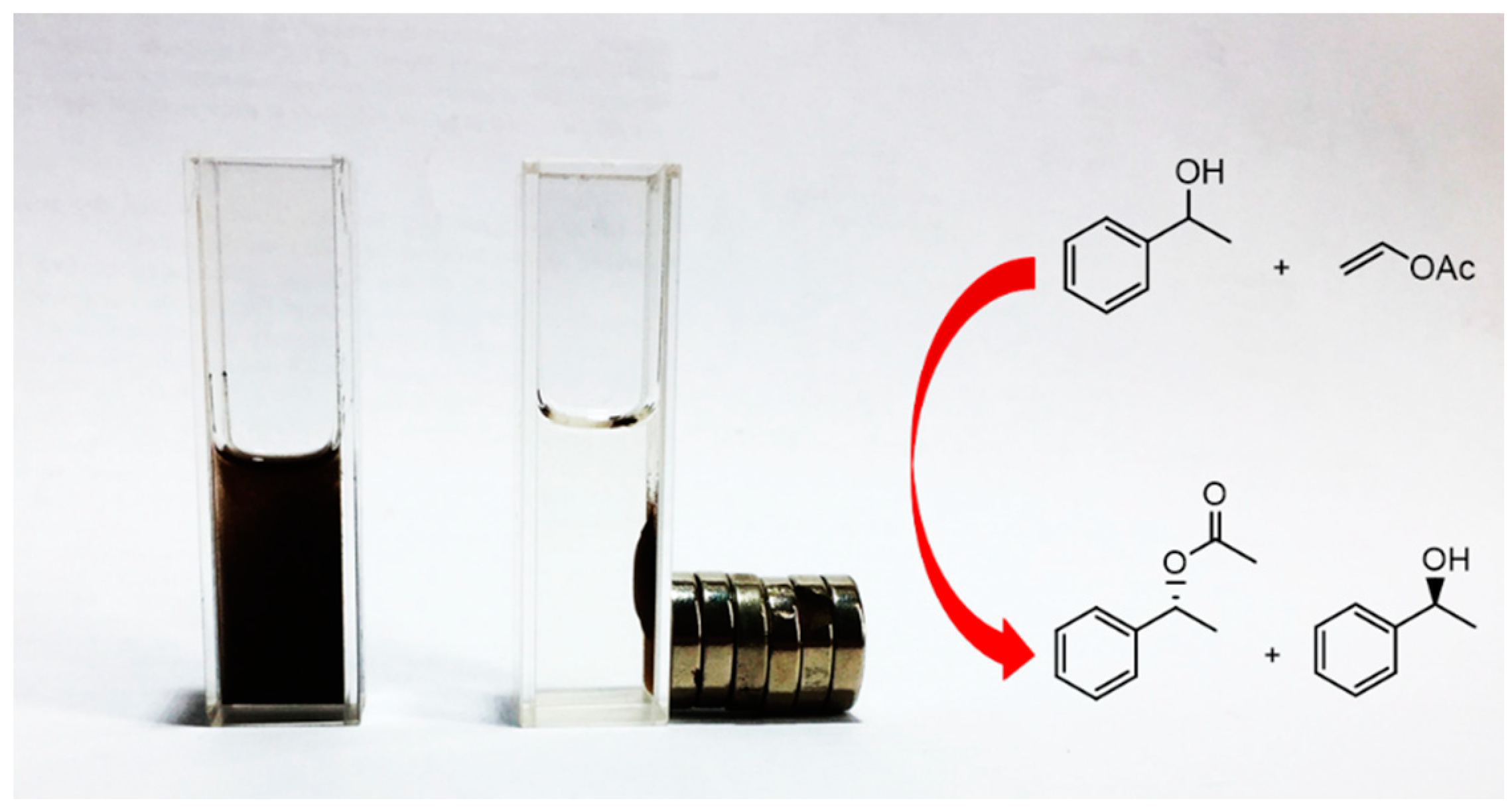

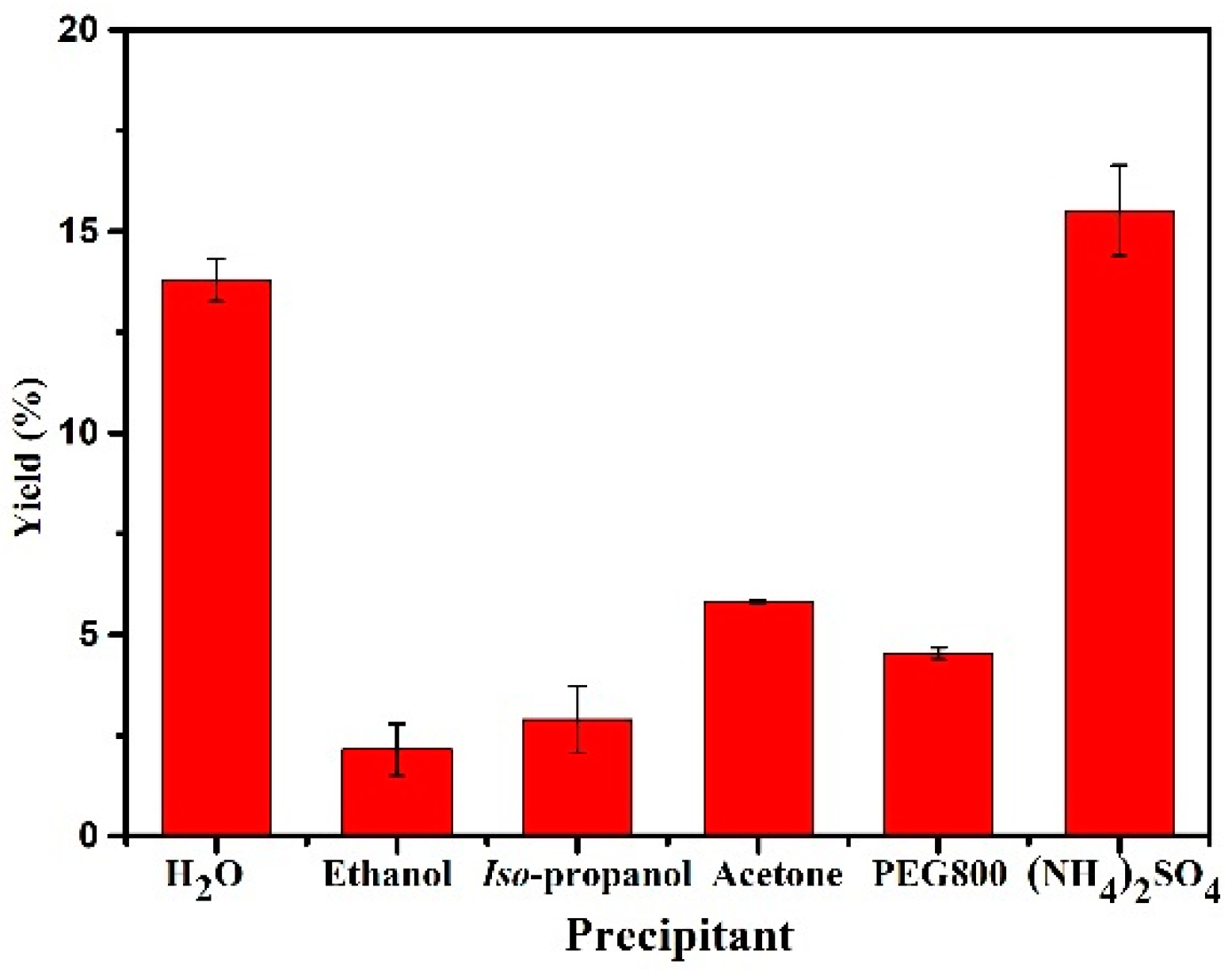
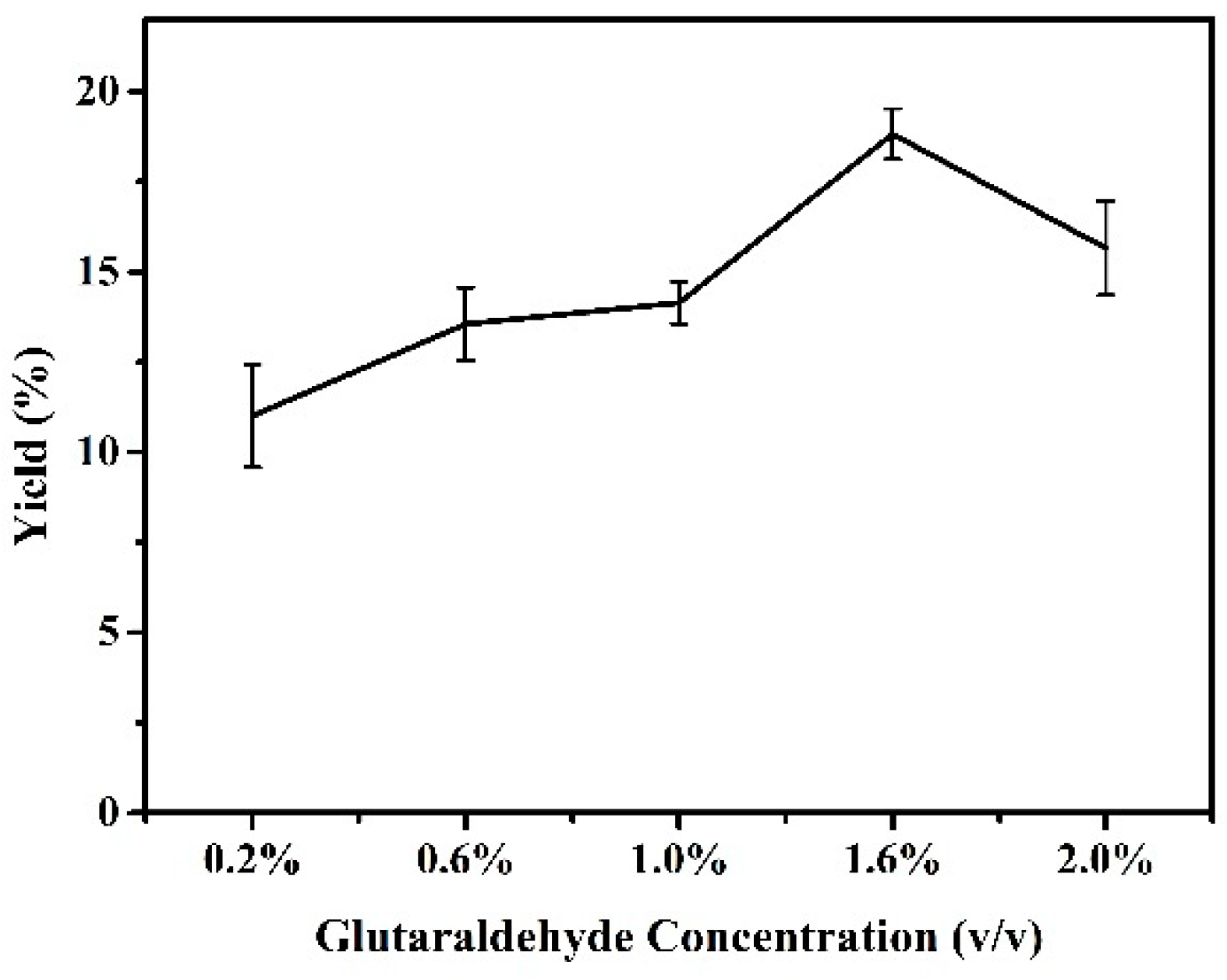
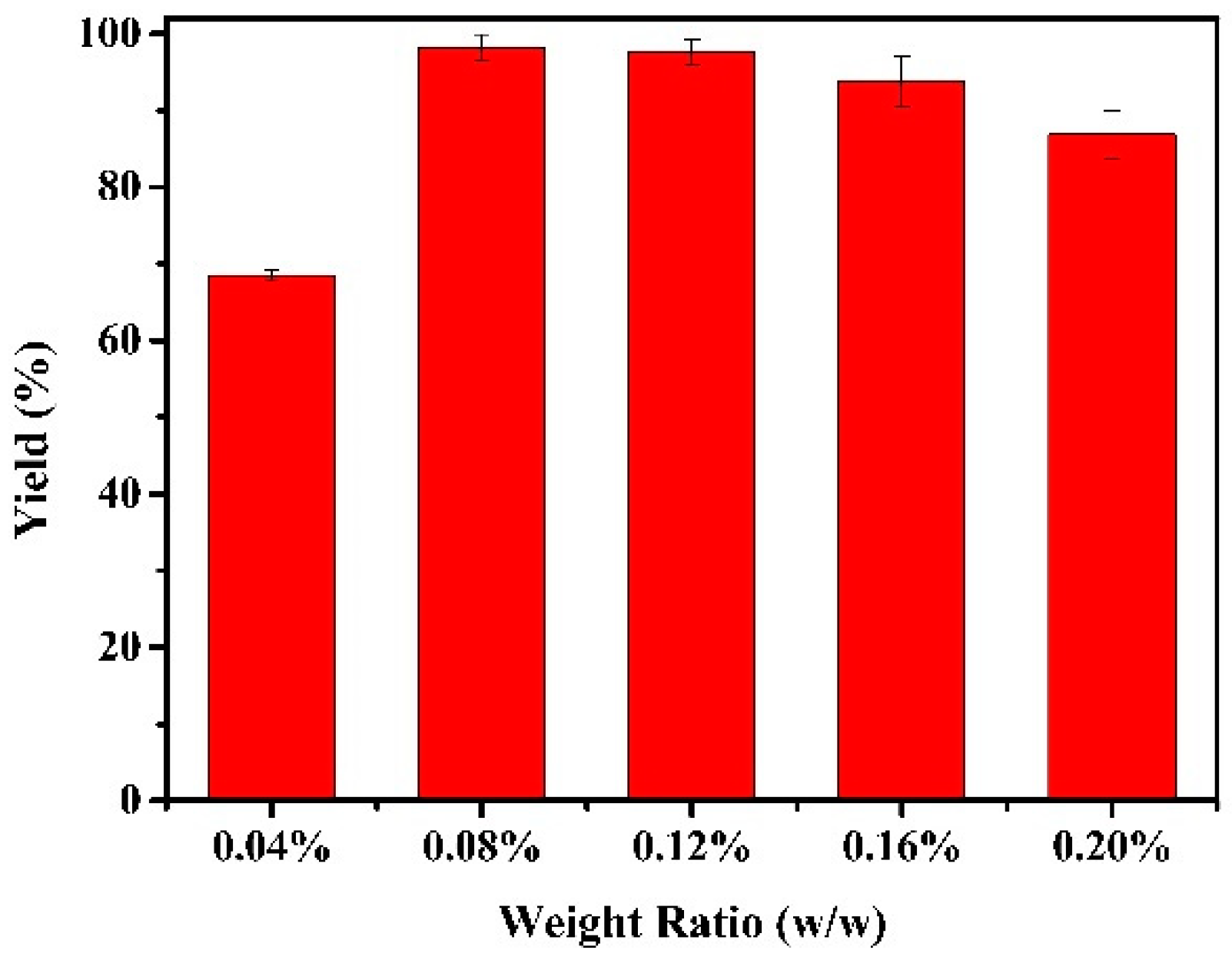

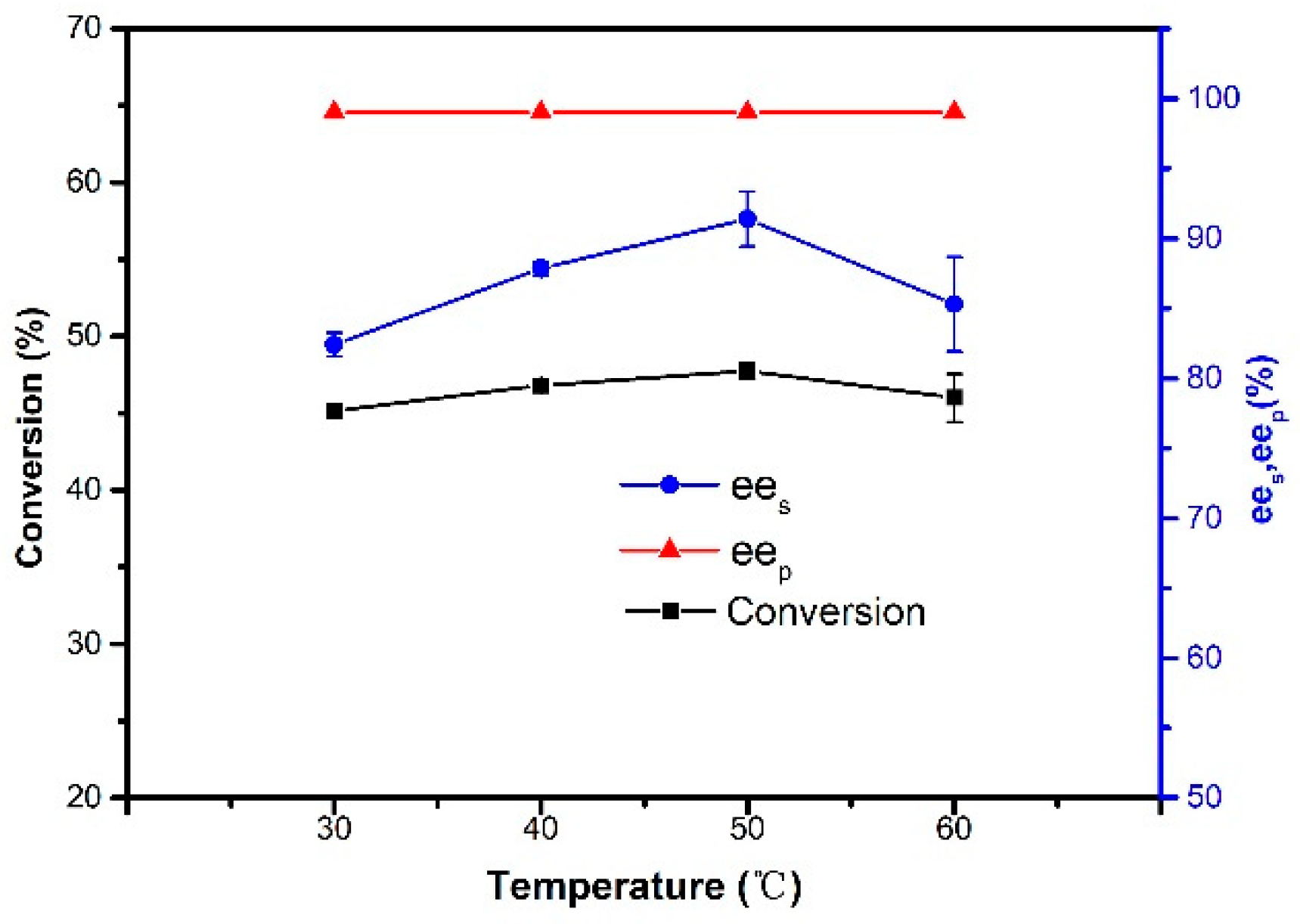
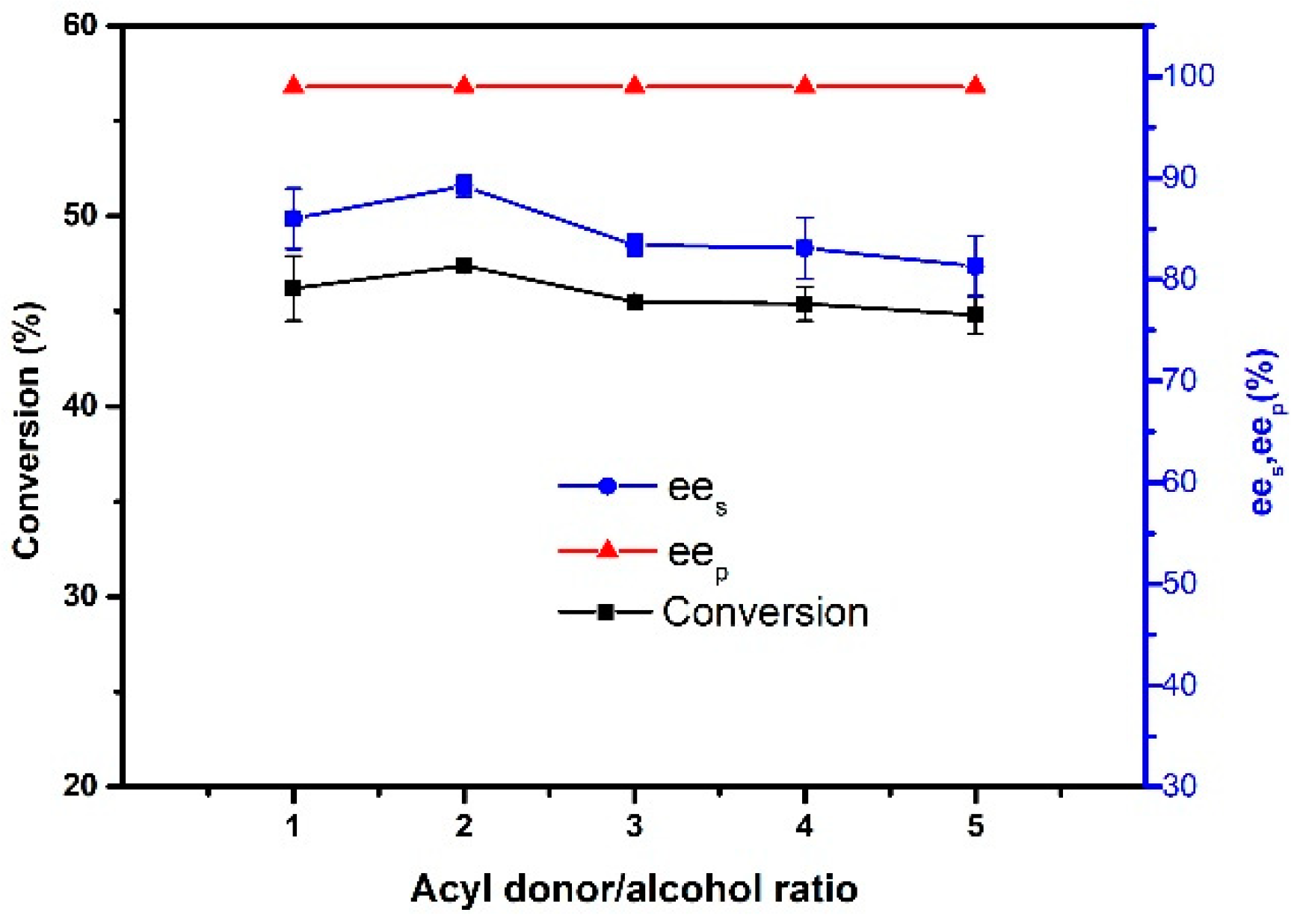
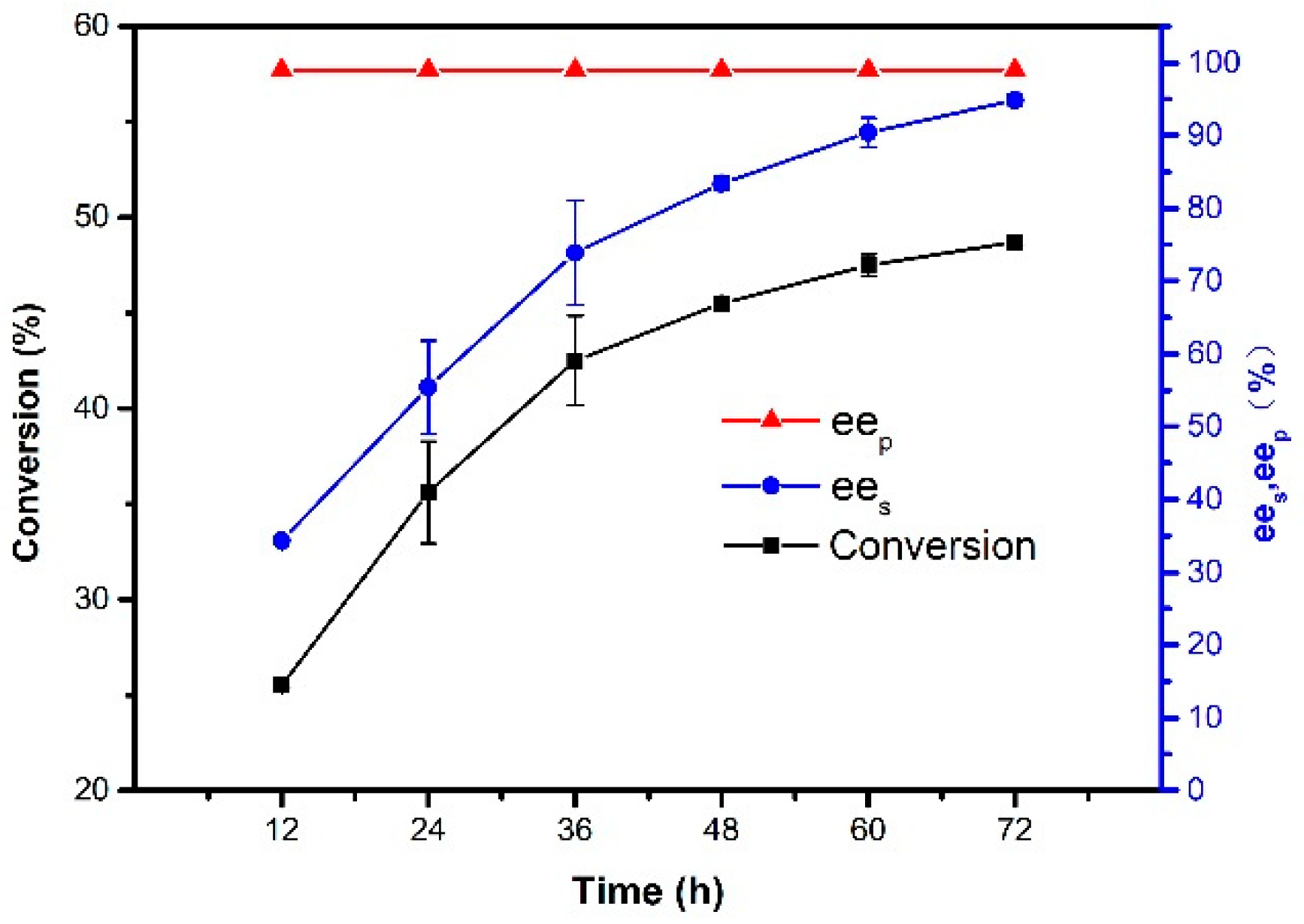
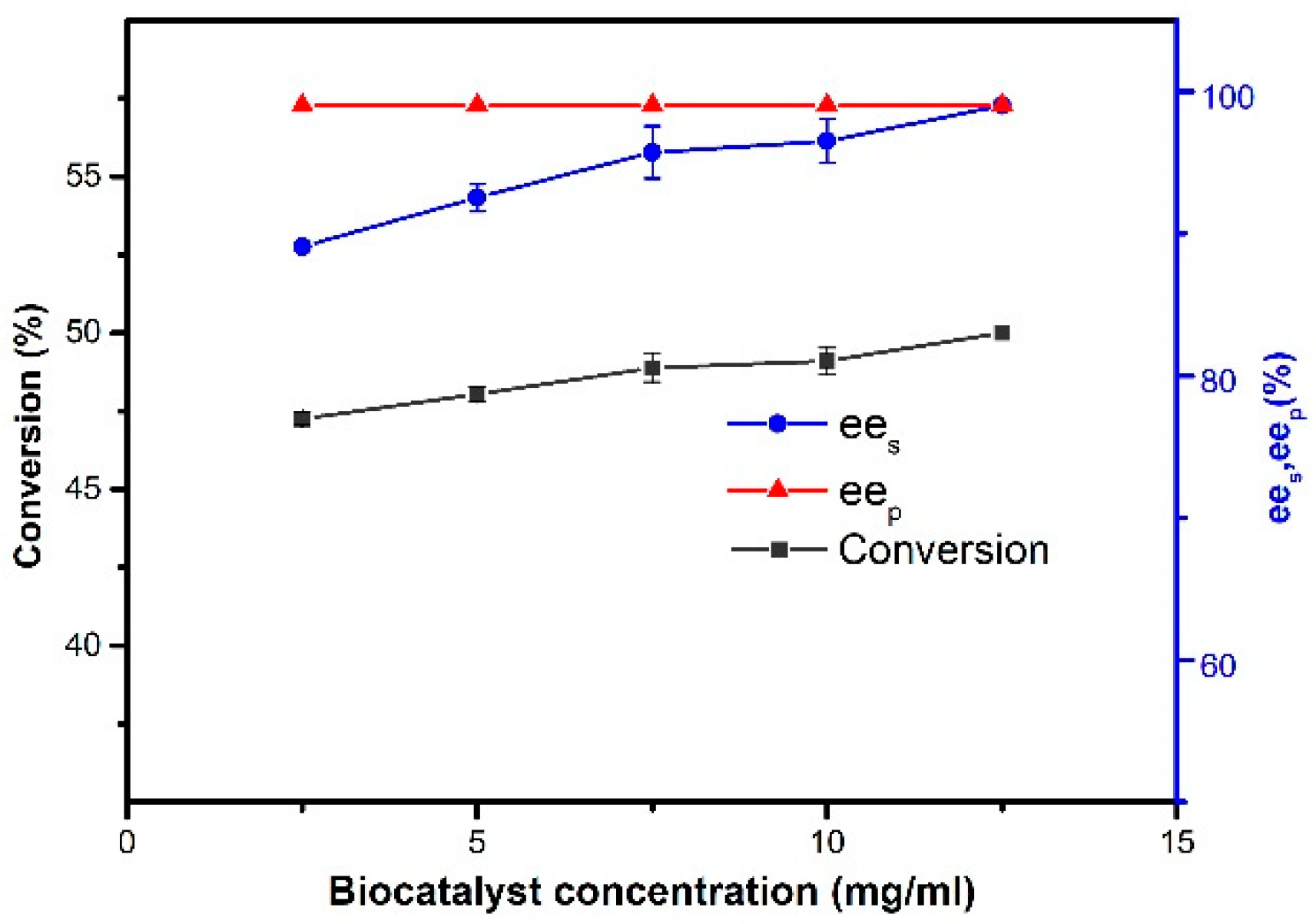
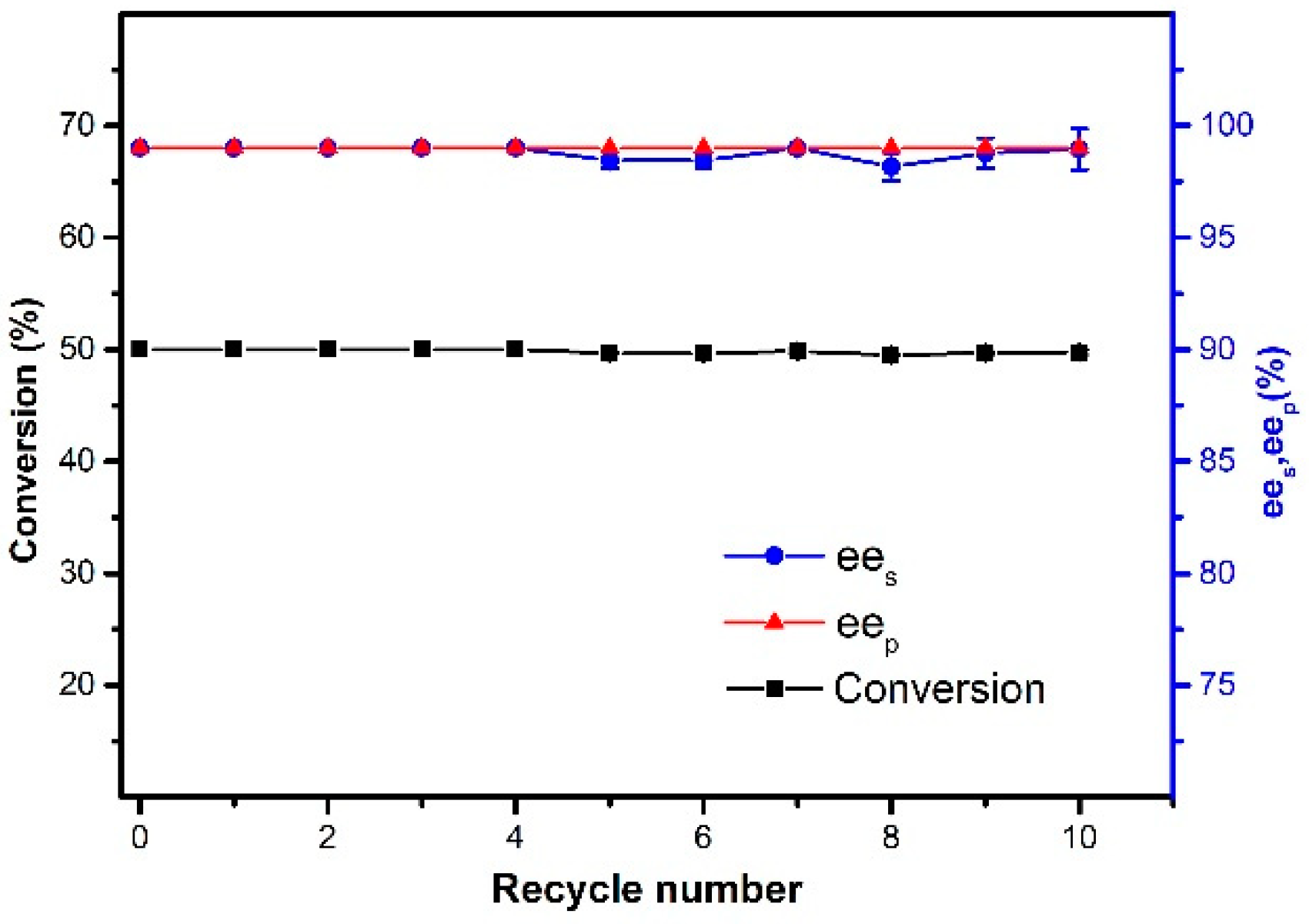

| Solvents | Log P b | eep% | ees% | C% | E |
|---|---|---|---|---|---|
| 1,4-Dioxane | −1.1 | 38 | 3 | 5.9 | 2 |
| Acetonitrile | −0.33 | >99 | 3 | 3.2 | 206 |
| Isopropanol | 0.25 | >99 | 1.4 | 1.4 | 202 |
| Tetrahydrofuran | 0.46 | >99 | 5.4 | 5.2 | 210 |
| Methyl tert-butyl ether | 0.96 | >99 | 42 | 29.9 | 300 |
| Isopropyl ether | 1.9 | >99 | 46 | 31.8 | 316 |
| Toluene | 2.5 | >99 | 56 | 36.2 | 351 |
| Hexane | 3.5 | >99 | 88 | 47.1 | 587 |
| Heptane | 4.0 | >99 | 85 | 46 | 546 |
| Isooctane | 4.5 | >99 | 78 | 44.0 | 478 |
| Entry | Substrate | Catalyst | eep b(%) | ees b(%) | Conversion b (%) | E |
|---|---|---|---|---|---|---|
| 1 |  | Magnetic CALB CLEAs | >99 | >99 | 50.0 | >1000 |
| Novozym 435 | 96 | >99 | 51.1 | 175 | ||
| Free CALB | >99 | 2 | 2.1 | 204 | ||
| Fe3O4 | >99 | 1 | 1.3 | 203 | ||
| APTES–Fe3O4 | >99 | 2 | 1.9 | 204 | ||
| 2 |  | Magnetic CALB CLEAs | >99 | 94 | 48.4 | >1000 |
| Novozym 435 | 94 | 98 | 50.9 | 149 | ||
| 3 |  | Magnetic CALB CLEAs | 95 | 43 | 31.0 | 56 |
| Novozym 435 | 35 | 74. | 68.1 | 4 | ||
| 4 |  | Magnetic CALB CLEAs | 94 | 28 | 22.6 | 43 |
| Novozym 435 | 30 | 98 | 76.3 | 7 | ||
| 5 |  | Magnetic CALB CLEAs | >99 | >99 | 50.0 | >1000 |
| Novozym 435 | 8 | >99 | 92.1 | 4 | ||
| 6 |  | Magnetic CALB CLEAs | 95 | 7 | 7.1 | 39 |
| Novozym 435 | 97 | 63 | 39.2 | 128 | ||
| 7 |  | Magnetic CALB CLEAs | / | 0 | 0 | / |
| Novozym 435 | >99 | <1 | 0.6 | 200 | ||
| 8 |  | Magnetic CALB CLEAs | 92 | 22 | 19.4 | 31 |
| Novozym 435 | 91 | >99 | 52.1 | 109 | ||
| 9 |  | Magnetic CALB CLEAs | >99 | 83 | 45.5 | 605 |
| Novozym 435 | 95 | >99 | 51.0 | 207 | ||
| 10 |  | Magnetic CALB CLEAs | >99 | >99 | 50.0 | >1000 |
| Novozym 435 | 94 | >99 | 51.4 | 160 | ||
| 11 |  | Magnetic CALB CLEAs | >99 | 78 | 44.0 | 472 |
| Novozym 435 | >99 | >99 | 50.0 | >1000 | ||
| 12 |  | Magnetic CALB CLEAs | >99 | 25 | 20.1 | 254 |
| Novozym 435 | >99 | >99 | 50.0 | >1000 | ||
| 13 |  | Magnetic CALB CLEAs | >99 | >99 | 50.0 | >1000 |
| Novozym 435 | >99 | >99 | 49.8 | >1000 | ||
| 14 |  | Magnetic CALB CLEAs | >99 | >99 | 50.0 | >1000 |
| Novozym 435 | 97 | >99 | 50.7 | 374 | ||
| 15 |  | Magnetic CALB CLEAs | >99 | >99 | 50.0 | >1000 |
| Novozym 435 | 95 | 2.8 | 2.8 | 45 |
© 2019 by the authors. Licensee MDPI, Basel, Switzerland. This article is an open access article distributed under the terms and conditions of the Creative Commons Attribution (CC BY) license (http://creativecommons.org/licenses/by/4.0/).
Share and Cite
Xing, X.; Jia, J.-Q.; Zhang, J.-F.; Zhou, Z.-W.; Li, J.; Wang, N.; Yu, X.-Q. CALB Immobilized onto Magnetic Nanoparticles for Efficient Kinetic Resolution of Racemic Secondary Alcohols: Long-Term Stability and Reusability. Molecules 2019, 24, 490. https://doi.org/10.3390/molecules24030490
Xing X, Jia J-Q, Zhang J-F, Zhou Z-W, Li J, Wang N, Yu X-Q. CALB Immobilized onto Magnetic Nanoparticles for Efficient Kinetic Resolution of Racemic Secondary Alcohols: Long-Term Stability and Reusability. Molecules. 2019; 24(3):490. https://doi.org/10.3390/molecules24030490
Chicago/Turabian StyleXing, Xiu, Jun-Qi Jia, Jing-Fan Zhang, Zi-Wen Zhou, Jun Li, Na Wang, and Xiao-Qi Yu. 2019. "CALB Immobilized onto Magnetic Nanoparticles for Efficient Kinetic Resolution of Racemic Secondary Alcohols: Long-Term Stability and Reusability" Molecules 24, no. 3: 490. https://doi.org/10.3390/molecules24030490
APA StyleXing, X., Jia, J.-Q., Zhang, J.-F., Zhou, Z.-W., Li, J., Wang, N., & Yu, X.-Q. (2019). CALB Immobilized onto Magnetic Nanoparticles for Efficient Kinetic Resolution of Racemic Secondary Alcohols: Long-Term Stability and Reusability. Molecules, 24(3), 490. https://doi.org/10.3390/molecules24030490




